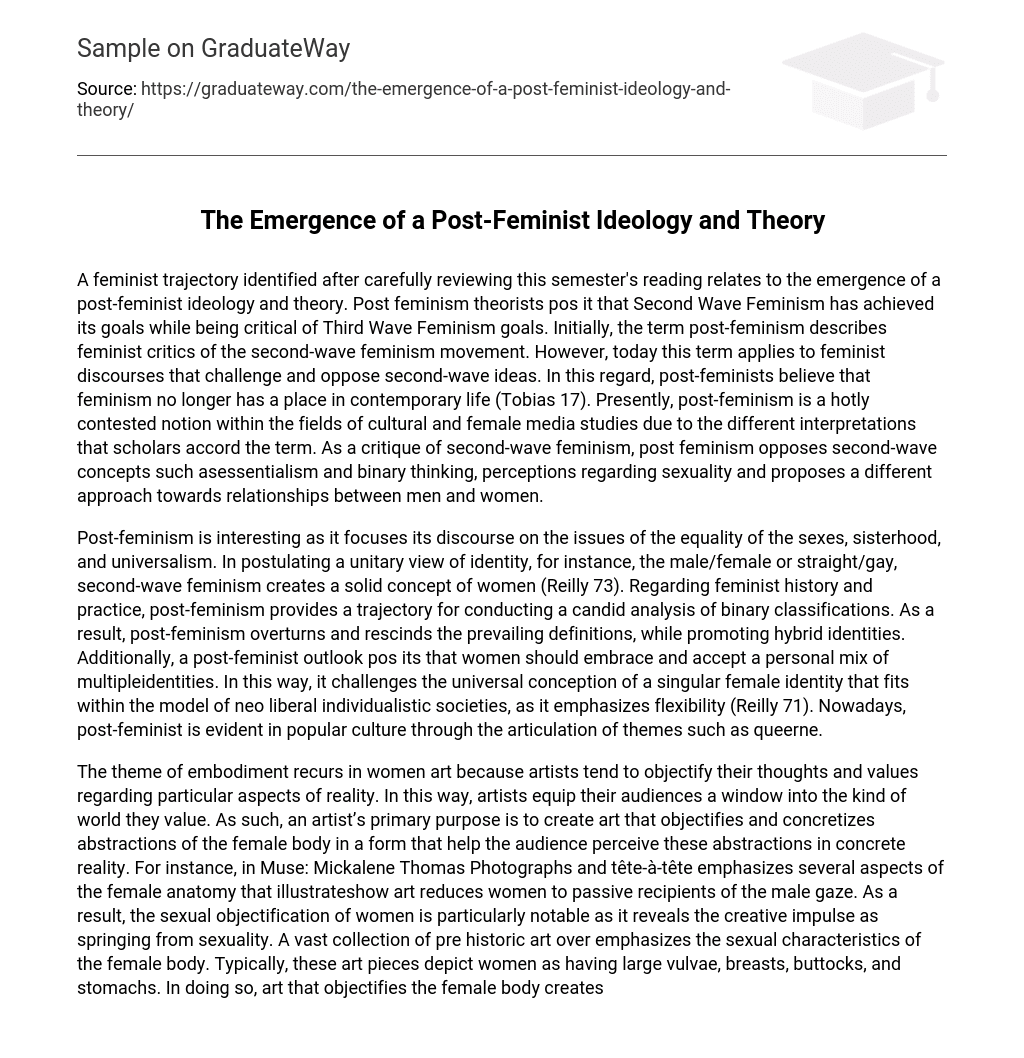A feminist trajectory identified after carefully reviewing this semester’s reading relates to the emergence of a post-feminist ideology and theory. Post feminism theorists pos it that Second Wave Feminism has achieved its goals while being critical of Third Wave Feminism goals. Initially, the term post-feminism describes feminist critics of the second-wave feminism movement. However, today this term applies to feminist discourses that challenge and oppose second-wave ideas. In this regard, post-feminists believe that feminism no longer has a place in contemporary life (Tobias 17). Presently, post-feminism is a hotly contested notion within the fields of cultural and female media studies due to the different interpretations that scholars accord the term. As a critique of second-wave feminism, post feminism opposes second-wave concepts such asessentialism and binary thinking, perceptions regarding sexuality and proposes a different approach towards relationships between men and women.
Post-feminism is interesting as it focuses its discourse on the issues of the equality of the sexes, sisterhood, and universalism. In postulating a unitary view of identity, for instance, the male/female or straight/gay, second-wave feminism creates a solid concept of women (Reilly 73). Regarding feminist history and practice, post-feminism provides a trajectory for conducting a candid analysis of binary classifications. As a result, post-feminism overturns and rescinds the prevailing definitions, while promoting hybrid identities. Additionally, a post-feminist outlook pos its that women should embrace and accept a personal mix of multipleidentities. In this way, it challenges the universal conception of a singular female identity that fits within the model of neo liberal individualistic societies, as it emphasizes flexibility (Reilly 71). Nowadays, post-feminist is evident in popular culture through the articulation of themes such as queerne.
The theme of embodiment recurs in women art because artists tend to objectify their thoughts and values regarding particular aspects of reality. In this way, artists equip their audiences a window into the kind of world they value. As such, an artist’s primary purpose is to create art that objectifies and concretizes abstractions of the female body in a form that help the audience perceive these abstractions in concrete reality. For instance, in Muse: Mickalene Thomas Photographs and tête-à-tête emphasizes several aspects of the female anatomy that illustrateshow art reduces women to passive recipients of the male gaze. As a result, the sexual objectification of women is particularly notable as it reveals the creative impulse as springing from sexuality. A vast collection of pre historic art over emphasizes the sexual characteristics of the female body. Typically, these art pieces depict women as having large vulvae, breasts, buttocks, and stomachs. In doing so, art that objectifies the female body creates conflict among feminists as the depiction of women as objects in film and art panders to the male need to evade sexual responsibility related to their sexual inadequacies. Besides that, the theme of an embodimentleads to hot debates about sexuality, pleasure, and gender identity as society conditions women to continuously survey themselves. Subsequently, women base their self-worth and identities on how they appear to others, which leads to unrealistic expectations and lifestyles. Given that, I think that the objectification of the female body performs a disservice to women, which feminism hopes to fix.
The two works of art reviewed in the documentaryWomen Art Revolution includes the artists Jeff Koons and Guerilla Girls. These pieces reflect the tendency that depicts women in art as sex objects which attenuates conflict between what people perceive as art and the authentic experiences of women. A significant factor responsible for the continued marginalization of women artists is the “political nature of imagery” and the definitions applied to what is acceptable female art (Lacy 68). For instance, the term “inside” applied to acceptable female art whereas “outside” art referred to ethnic, political, or feminist art (Lacy 67).Consequently, these artificial boundaries create a legacy, which overlooks, ignores, and discriminates against feminist art. Also, this legacy poses a serious question regarding the connection between art, society, the nature of power, and the relativity of the historical record regarding women artists.
The feminist agenda revolves around the achievement of social, political, cultural, and economic equality of both men and women. However, contemporary feminists differ due to the intersectionality of feminist ideas, the negative connotations associated with feminism, and different brands of feminism in use across the globe. Over the years, feminism has gained tremendous achievements in the globe as compared to 100 years ago. However, this does not mean that the struggle is over. Instead, I foresee a situation in which feminism becomes more akin to egalitarianism (Lacy 66). As society becomes equal, programs such as affirmative action will become redundant and unnecessary. In addition to that, the feminist agenda will focus on areas where discrimination still exists. Interestingly, conflict will occur within the feminist movement between those who prioritize the problems of women and those who tend to focus primarily on the problems facing men. Ideally, feminism should strive to address each problem based on its magnitude.





